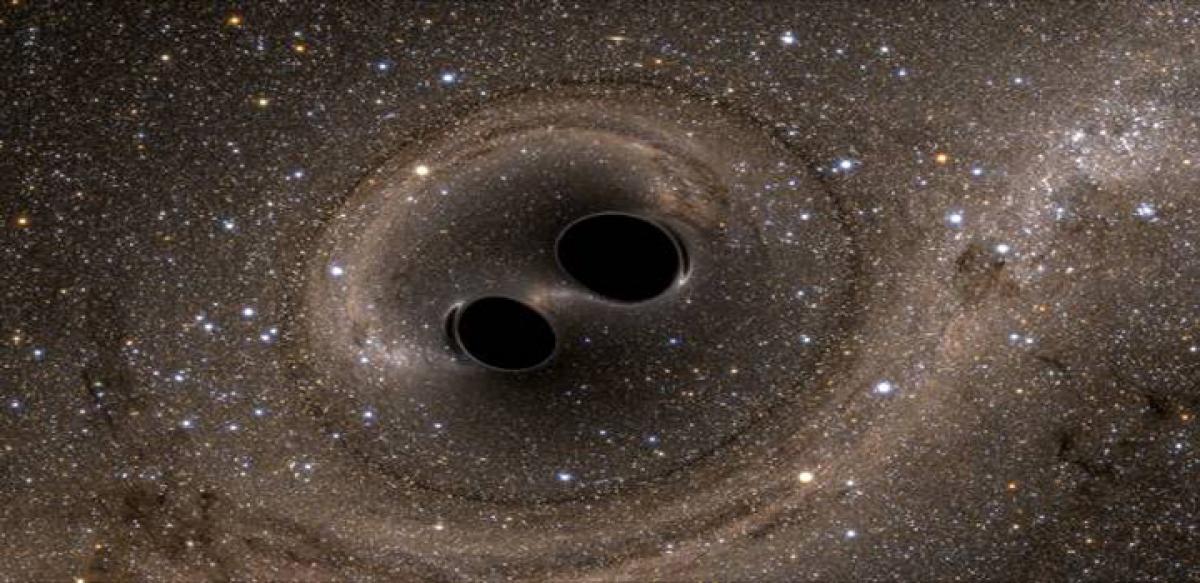Live
- Two Russian oil tankers with 29 on board damaged due to bad weather
- Telangana's Traditions Will Be Protected, Village by Village : BRS Leader MLC K. Kavitha
- Uganda to relocate 5,000 households from landslide-prone areas in eastern region
- Harish Rao Criticizes CM Revanth Reddy: "His Time is Over"
- Vijay Sethupathi Hails 'Vidudala-2' as a Theatrical Game-Changer
- Sahaj Yog: A Path to Inner Transformation and Harmony City takes giant strides
- Allu Arjun meets his uncle Nagababu at his residence
- J&K L-G felicitates Langar organisations & NGOs for contribution during Amarnath Yatra
- Hit by Covid, MP's Rakesh Mishra sees revival of his fortunes, courtesy PM SVANidhi scheme
- Trailblazing Yakshagana Artiste Leelavathi Baipaditthaya No More
Just In

The discovery of gravitational waves announced on Thursday has given momentum to Indian scientists hoping to be the first outside of the US to host the device that detected the signals from the collision of two black holes.
Around 30 Indians were part of a 1,000-strong team of researchers from 15 countries led by scientists at the California Institute of Technology and the MIT that made the discovery using detectors at the Laser Interferometer Gravitational-Wave Observatory (LIGO)
The discovery of gravitational waves announced on Thursday has given momentum to Indian scientists hoping to be the first outside of the US to host the device that detected the signals from the collision of two black holes.
Indian scientists contributed significantly to the decades long hunt for evidence of gravitational waves and in identifying that they were produced by the cosmic clash of black holes a billion light- years ago, according to a report by The Wall Street Journal.
The discovery verifies an unproven portion of Albert Einstein’s Theory of General Relativity and, because the waves are largely unimpeded by matter, offers a new way for astronomers to probe formerly hidden corners of the universe. Einstein first suggested the existence of gravitational waves in 1916.
Around 30 Indians were part of a 1,000-strong team of researchers from 15 countries led by scientists at the California Institute of Technology and the Massachusetts Institute of Technology, that made the discovery using detectors at the Laser Interferometer Gravitational-Wave Observatory (LIGO), The Wall Street Journal reported.
“I am so grateful for the major contributions, by Indian scientists working in India and abroad, that helped make this discovery and future discoveries possible,” said Kip Thorne, a Caltech theoretical physicist and co-founder of the LIGO project, in a statement.
Indian data analysts developed and implemented techniques to find gravitational-wave signals amid noise and the country’s theorists computed the shapes of the signals, he added. On Thursday, a tweet from Prime Minister Narendra Modi said he was “immensely proud that Indian scientists played an important role in this challenging quest.”
Such a device would be the first in the world outside of the US, where two mammoth laser installations—one set in Hanford, Wash., and the other in Livingston, La.—operate in tandem to cross-check their results.
The LIGO detectors measure how long it takes controlled laser light to travel between suspended mirrors.
Passing ripples in space-time alter the distance measured by the light beam, causing the amount of light falling on the LIGO photo detectors to vary infinitesimally. By Einstein’s reasoning, any object with mass warps the curvature of space and time, like a bowling ball on a trampoline. It stirs space and time, generating waves that radiate at the speed of light.
A third detector placed outside the US could enable scientists to pinpoint the place in the sky where events producing gravitational waves took place, said Rajesh Gopakumar, director of the International Centre for Theoretical Sciences in Bangalore, where a group of seven scientists collaborated with the LIGO project to prove that the signals were produced by gravitational waves.
“This will truly help with gravitational-wave astronomy. We are all hoping that the go ahead is given through the momentum of this discovery,” Prof. Gopakumar said. “We could find more, do more precision experiments and know where things are coming from.”
The LIGO-India project, proposed by IndIGO — a consortium of scientists from institutions in India and around the world — would move one of two LIGO devices from Hanford to the South Asian nation and add another new but identical detector, The Wall Street Journal reported.
It would be operated jointly by IndIGO and the LIGO-Lab project, according to the website for the project and is currently under consideration by science-funding agencies in India and the US. There are other gravitational-wave detectors outside the US, but they are tuned to different frequencies.

© 2024 Hyderabad Media House Limited/The Hans India. All rights reserved. Powered by hocalwire.com







